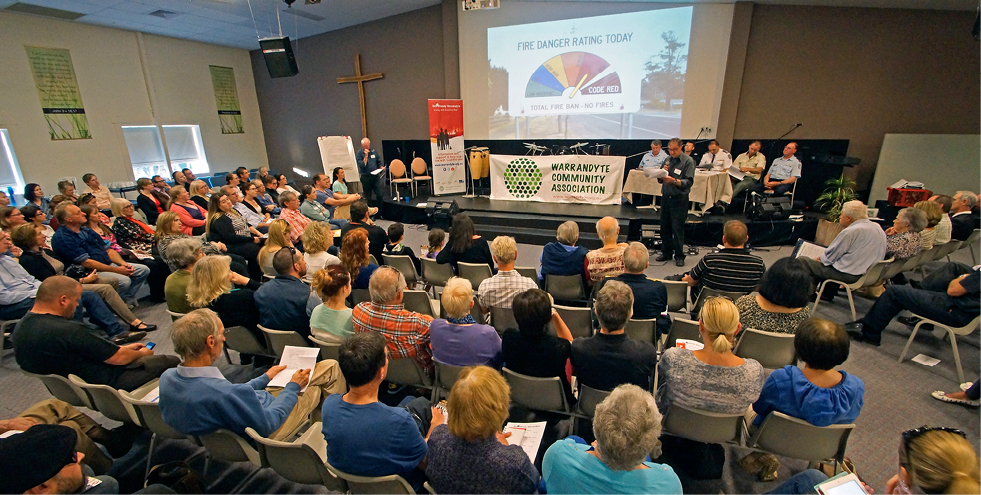
By Dr Blythe McLennan, Bushfire and Natural Hazards CRC and RMIT University

Dr Blythe McLennan
How can a well-organised, capable, and respected community group help improve local community bushfire safety and build resilience in a high risk area? That is the question the research team for the Bushfire and Natural Hazards CRC Out of Uniform project1 explored in a case study of a community-led bushfire preparedness project called Be Ready Warrandyte. Along the way, the case study raised questions about the appetite of the emergency management sector for supporting community-led preparedness and planning.
Be Ready Warrandyte (Be Ready)2 was a project of the Warrandyte Community Association, undertaken between May 2012 and June 2015. Its primary goal was to have more Warrandyte households with effective bushfire plans. It rolled out a range of locally-tailored and, from an emergency management perspective, quite innovative communication and education activities and products. It did this with direct support from the Country Fire Authority (CFA), local government staff and local CFA brigade captains. Its philosophy was to inform and engage local residents, businesses and community groups, but not to advise people what to do.
Be Ready was of great interest to myself and my colleagues Dr Josh Whittaker and Professor John Handmer because it is an illustrative example of extending volunteerism in disaster preparedness. This form of volunteerism occurs when volunteers associated with an existing community group or non-government organisation that does not have regular emergency or disaster management functions (e.g. the Warrandyte Community Association), extend their activities into the areas of disaster management or community resilience in response to a perceived need. Be Ready was also interesting to us because it involved a high degree of collaboration between non-traditional emergency volunteers who are not affiliated with emergency management organisations, traditional emergency management volunteers, and paid emergency services staff.
Overall, the Be Ready case study3 shows how a community-led project with strong leadership and governance, authorised by the community and supported by emergency management organisations, was able to achieve many outcomes. Be Ready adapted government communications, connected further into the community, devised and tested more innovative approaches, lead discussion on topics that needed independence from perceptions of government bias or agenda, and brought local contexts, priorities, goals and knowledge into emergency management dialogues and planning. These are all good results.

A cartoon developed to help promote the Be Ready Warrandyte cause.
Reflecting on the case study, however, I am particularly struck by the difficult balance participants in community-led projects have to strike between working with the established emergency management system, while also seeking to challenge or influence it at the same time. Notably, this point applies to all participants, whether they are supporting the project as volunteers or paid staff, as representatives of a local community, an emergency management organisation, or any combination of the above. It may be a particularly thorny issue for traditional emergency management volunteers who arguably have the most difficult line to walk between representing the goals, priorities and concerns of their organisation, and their local community at the same time. Of course this is much easier to do when these goals, priorities and concerns are closely aligned, but given the particular and diverse settings, histories and conditions of different communities this is not always going to be the case.

A Be Ready Warrandyte scenario planning workshop, where a facilitator stepped through a hypothetical fire scenario, allowing community members to test household plans and actions and gain feedback from emergency management organisations.
In the case of Be Ready, a fairly moderate stance was adopted and the group worked in a way that was, for the most part, well-aligned with state and local government policy and well-supported by emergency management organisation representatives. Overall, there was strong consensus between the community volunteers and emergency management organisation representatives, and few significant points of difference. One notable difference that did exist was the issue of how to deal with the mounting interest of residents to learn about and install private fire bunkers. This issue is approached cautiously in Victorian state policy, but the Be Ready program engaged with it more actively and partly in a way that was not supported by emergency management representatives involved.
Importantly, there were both positive and negative consequences from adopting this more moderate stance. For Be Ready participants, the positives clearly outweighed the negatives. On the positive side, for example, it facilitated emergency management organisation support and trust in the project and the volunteers leading it, which in turn enabled them to support it in valuable ways. It also enabled more open, ‘gloves off’ discussion about contentious issues like private fire bunkers, as well as local road management. On the negative side, however, it restricted what the project was able to tackle and how. It also left the Be Ready project open to criticism of being little more than a mouthpiece for government policy; although such criticism was not widespread.
This raises an important question for the future of community-led preparedness and planning. While there is growing support for community-led approaches among emergency management organisations, how far can this support extend when faced with major differences in government and agency policy on one hand and local community priorities and values on the other? How far is ‘just enough’ to enable community-led projects to foster greater shared responsibility and build resilience to disasters, without being ‘too much’ for what is in many respects a risk averse sector? Of course there are important community safety and legal issues involved in this, but there is also an issue of the appetite of the emergency management sector to share responsibility with communities in practice. More importantly, how will differences in perspective, values, goals, and priorities in community safety and local emergency planning be negotiated between those who have statutory responsibility and risk management expertise, and those who have local knowledge and who personally live with the consequences, whatever they may be?
The Be Ready Warrandyte case study and more research from the Out Of Uniform project is at
www.bnhcrc.com.au.
1 Out of Uniform project. At: www.bnhcrc.com.au/research/resilient-people-infrastructure-and-institutions/248.
2 Be Ready Warrandyte. At: http://warrandyte.org.au/fire/.
3 Be Ready case study. At: www.bnhcrc.com.au/publications/biblio/bnh-2103.